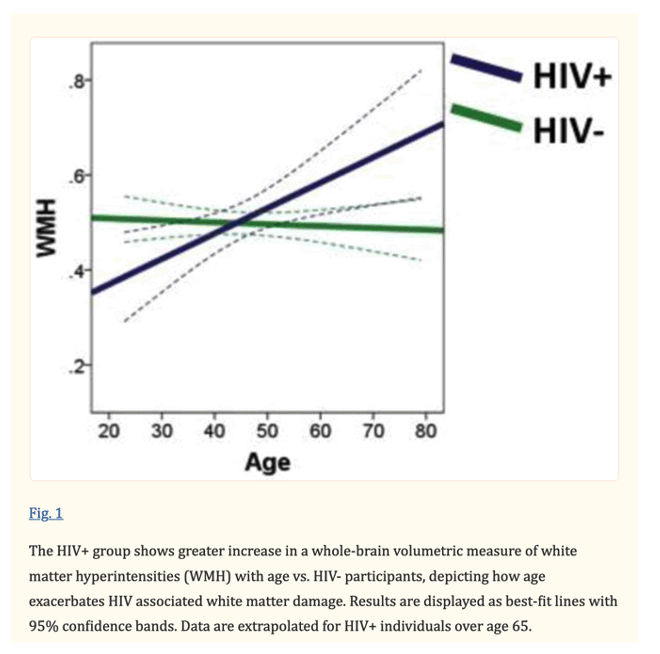| |
Age Exacerbates HIV-Associated White Matter Abnormalities
|
| |
| |
Download the PDF here
2016 April
The present study is a cross-sectional design and thus has several inherent limitations. We cannot determine that the white matter structure in these study participants changed from a premorbid state, nor can we conclude that it reflected damaged caused directly by HIV.
We predict that overall WMH and ROIs vulnerable to HIV will show the greatest evidence of interactive effects of age and HIV.
In sum, the interaction between age and HIV was even stronger among healthier participants who did not have detectable HIV or HCV coinfection.
Controlling for the effects of HCV and education did not significantly alter any findings.
In conclusion, aging and HIV are associated with white matter damage and interact as risk factors for WMH increase and FA decline. FLAIR imaging may still be a clinically relevant tool to measure white matter abnormalities in middle-aged and older people with HIV, whereas DTI may be more useful for assessing age related white matter changes in middle-aged seronegative adults. Given that the current study population was relatively healthy and functionally intact, findings reflect early changes in white matter, which occur in frontal and subcortical areas in the context of HIV. Discovering early signs of decline gives an opportunity to aggressively treat modifiable risk factors for white matter damage, such as HCV, before the development of significant functional impairments. As the population with HIV ages, it will continue to be important to investigate the effects of the disease, comorbid conditions, and age on brain structure and function.
Abstract
Both HIV disease and advanced age have been associated with alterations to cerebral white matter, as measured with white matter hyperintensities (WMH) on fluid attenuated inversion recovery (FLAIR) magnetic resonance imaging (MRI), and more recently with diffusion tensor imaging (DTI). This study investigates the combined effects of age and HIV serostatus on WMH and DTI measures, as well as the relationships between these white matter measures, in 88 HIV seropositive (HIV+) and 49 seronegative (HIV-) individuals aged 23-79 years. A whole-brain volumetric measure of WMH was quantified from FLAIR images using a semi-automated process, while fractional anisotropy (FA) was calculated for 15 regions of a whole-brain white matter skeleton generated using tract-based spatial statistics (TBSS). An age by HIV interaction was found indicating a significant association between WMH and older age in HIV+ participants only. Similarly, significant age by HIV interactions were found indicating stronger associations between older age and decreased FA in the posterior limbs of the internal capsules, cerebral peduncles, and anterior corona radiata in HIV+ vs. HIV- participants. The interactive effects of HIV and age were stronger with respect to whole-brain WMH than for any of the FA measures. Among HIV+ participants, greater WMH and lower anterior corona radiata FA were associated with active hepatitis C virus infection, a history of AIDS, and higher current CD4 cell count. Results indicate that age exacerbates HIV associated abnormalities of whole-brain WMH and fronto-subcortical white matter integrity.

|
|
| |
| |
|
|
|